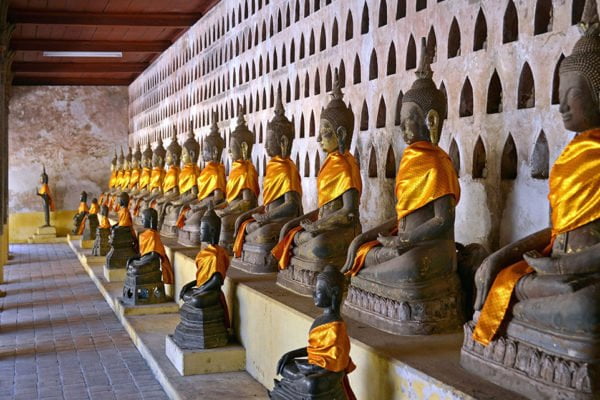Wandering Around The UNESCO World Heritage Sites In Southeast Asia
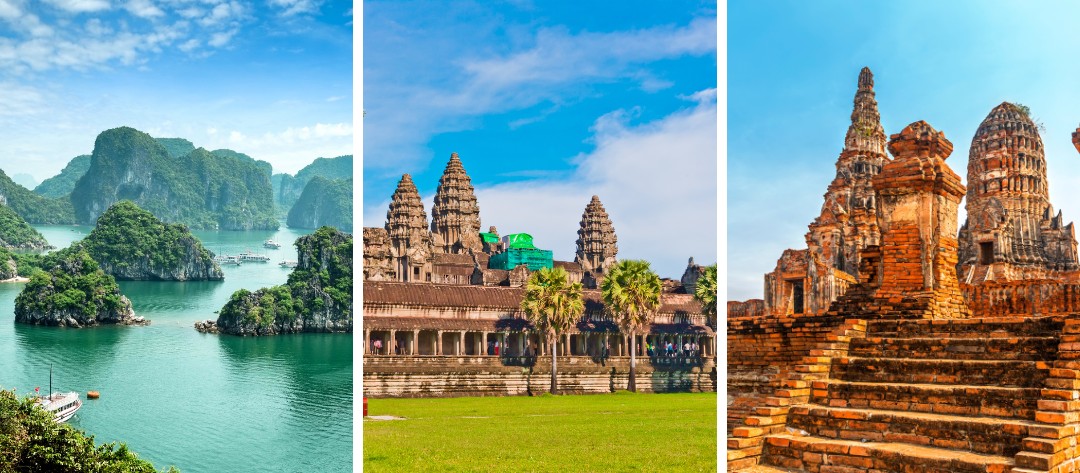
Southeast Asia is a treasure trove waiting to be discovered. Within this vibrant and historic region lie some of the most culturally significant places on Earth, the UNESCO World Heritage sites in Southeast Asia that will ignite your sense of wonder and fill your soul with amazement. Open your mind and take a journey to these landmarks of human achievement.
Top 7 UNESCO World Heritage Sites In Southeast Asia
Halong Bay, Vietnam
A beautiful site located in the Gulf of Tonkin, Halong Bay comprises around 1,600 islands and islets, which form a stunning seascape of limestone pillars. It was first recognized by UNESCO in 1994 for its outstanding scenic beauty.
Most of the islands are uninhabited and remain untouched by human presence, adding to the site’s appeal, while the gradual process of erosion has formed concealed caves and striking arches in various locations. The natural beauty of Halong Bay is truly remarkable, with its precipitous nature and great biological interest.

Marvelous view of Halong Bay
Top Things To Do In Halong Bay
- Exploring Hidden Caves
Halong Bay is home to a network of mystical caves, each with its own unique charm. One of the most famous caves is the Sung Sot Cave, also known as the “Surprising Cave.” As you venture into its vast chambers, you’ll discover an otherworldly landscape adorned with stalactites and stalagmites, illuminated by artistic lighting. Other notable caves include Thien Cung Cave and Dau Go Cave, each offering a mesmerizing glimpse into the geological wonders of the region.
>> Read More: Top 10 Caves In Vietnam – Discover The Incredible Gifts From Nature
- Kayaking and Swimming Adventures
For those seeking a more active experience, kayaking through Halong Bay’s emerald waters is an excellent choice. Paddle your way through hidden lagoons, under towering cliffs, and into secluded caves, immersing yourself in the tranquility of this natural paradise. You can also take a refreshing dip in the bay’s pristine waters, surrounded by the majestic karsts, creating memories that will last a lifetime.
- Floating Village Discoveries
Halong Bay’s floating villages provide a unique cultural experience. Cua Van Floating Village is the largest of its kind in the bay, where you can witness the daily lives of local fishermen and learn about their traditional fishing techniques. Interact with the friendly villagers, visit their floating schools and fish farms, and gain a deeper insight into the rich heritage and resilience of the local communities.
- Indulge in a Luxury Cruise Experience
Halong Bay offers a range of opulent cruise options for travelers seeking the epitome of luxury and comfort. Let’s step aboard a lavish cruise ship equipped with elegant cabins, world-class amenities, and impeccable service. These luxury cruises provide a truly indulgent experience, allowing you to relax and unwind in style as you navigate the stunning vistas of Halong Bay. Enjoy gourmet dining with delectable Vietnamese and international cuisine, rejuvenate with spa treatments on board, and savor the panoramic views from the sundeck.
>> Read More: Top 19 Best Cruises In Halong Bay For A Luxury Holiday
Hoi An Ancient Town, Vietnam
Hoi An was once the main trading post in Southeast Asia during the 16th and 17th centuries, and it still maintains its unique charm today with a variety of notable old-town architecture.
The old town can be considered a living museum, where you can find Chinese temples, a Japanese-designed bridge, pagodas, wooden shop houses, French colonial houses, and old canals. Although large-scale trading has moved elsewhere, Hoi An town has been successful in preserving and restoring its charming roots and was declared a UNESCO World Heritage site in December 1999.
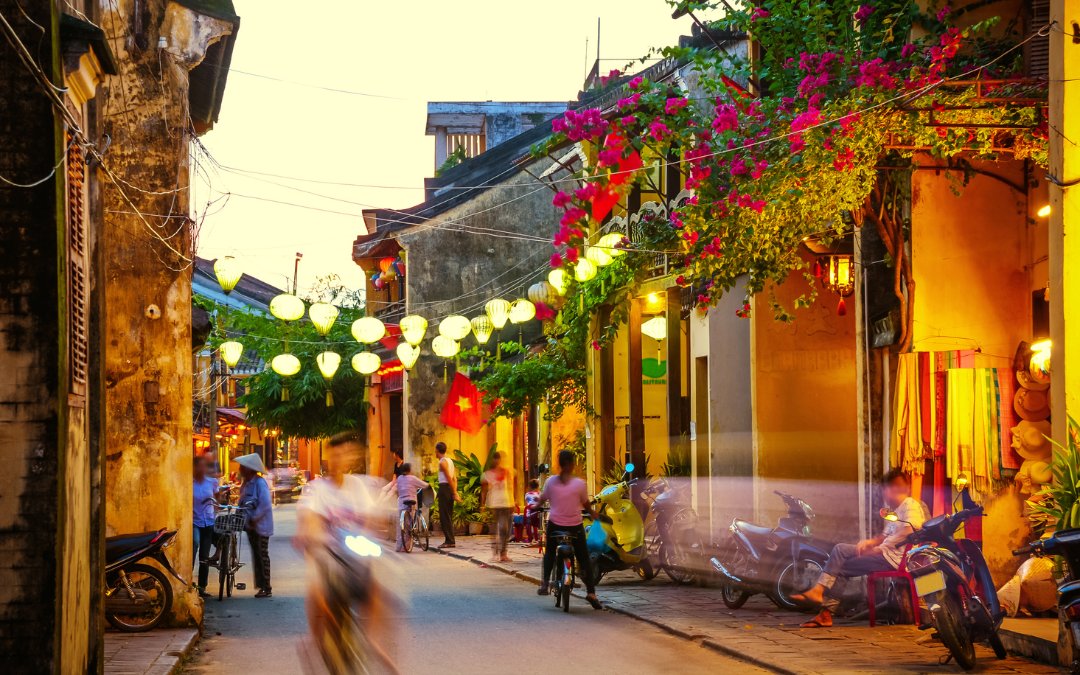
The tranquil vibe at Hoi An old town
Things To Do In Hoi An Ancient Town
- Visit the Japanese Covered Bridge
Visit the Japanese Covered Bridge in Hoi An, an iconic 18th-century bridge with intricate carvings and a small temple inside. According to legend, it was built by the Japanese community to connect with the Chinese quarter of the town. Admire its architectural beauty and multicultural heritage, and capture memorable photographs.
- Explore the Tailor Shops and Boutiques
Hoi An is renowned for its skilled tailors and vibrant fashion scene. Visit one of the many tailor shops and boutiques to have custom-made clothing created just for you. From traditional Vietnamese ao dai to modern designs, the talented craftsmen and women of Hoi An can bring your fashion dreams to life.
Additionally, the town is home to a wide range of boutique stores offering handmade crafts, accessories, and unique souvenirs for you to take home as cherished mementos of your visit.
- Experience the Lantern Festival
If you visit Hoi An during the full moon, you’ll be treated to the magical Lantern Festival, known as the “Hoi An Full Moon Festival.” Watch as the Ancient Town transforms into a mesmerizing wonderland, with thousands of colorful lanterns illuminating the streets, traditional music filling the air, and locals and visitors alike releasing floating lanterns on the river.
- Enjoy Culinary Delights
Hoi An is a culinary paradise, offering an array of delicious Vietnamese dishes and unique regional specialties.
Embark on a culinary adventure by taking a cooking class and learning the secrets of Vietnamese cuisine. Visit local markets to discover fresh ingredients, and then master the art of preparing iconic dishes like pho, banh mi, and fresh spring rolls. Don’t forget to indulge in Hoi An’s famous cao lau, a noodle dish unique to the region.
>> Read More: 14 Vietnam Historical Landmarks To Learn About The Country’s Intriguing Past
Angkor Wat, Cambodia
The Angkor Wat is a magnificent temple complex consisting of over 300 temples. It was built in the 12th century and was once hidden from view, obscured by a dark sky and protected by a dense jungle. This adds to the mystery and intrigue of the complex.
When standing in front of Angkor, one can feel the weight of Khmer history and culture flowing through them. Every detail, from the architecture to the art, suggests that this temple was created for something important and greater than any human being. Even the smallest details have been crafted to strive for perfection, making this place a true embodiment of artistic perfection and sacredness.
Exploring the vast complex can take several days, with must-see temples such as the beautifully restored Angkor Wat, the root-covered Ta Prohm, and the grandiose Bayon.
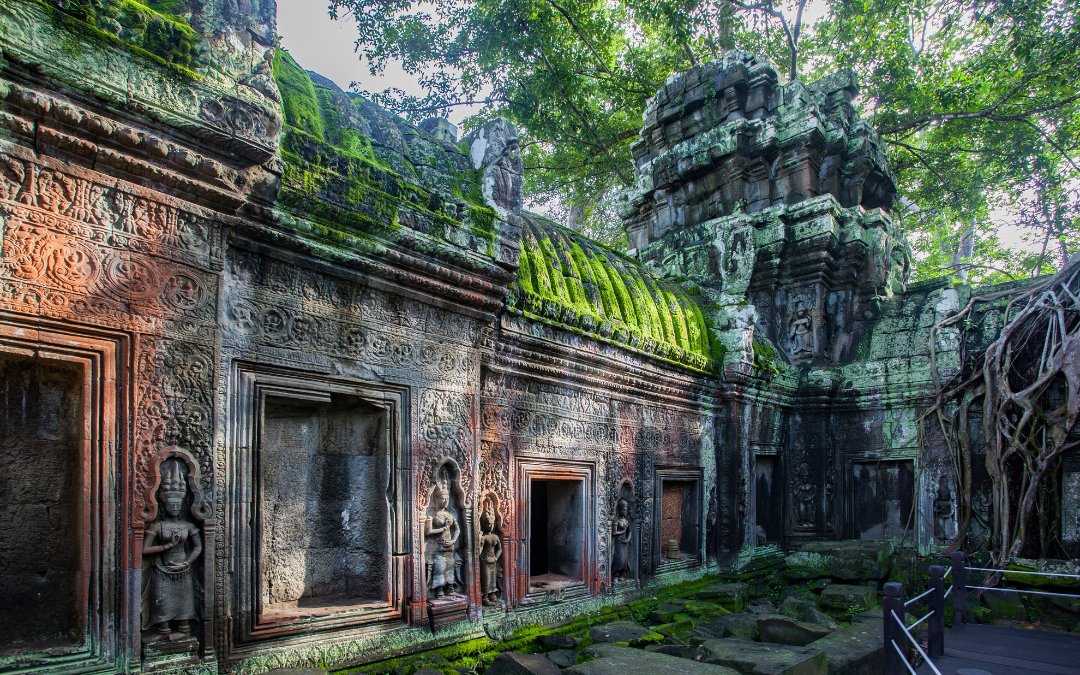
Inside the Angkor Wat in Siem Reap, Cambodia
Things To Do in Angkor Wat
- Marvel at the Magnificent Temples
Begin your journey with the iconic Angkor Wat temple itself, a symbol of Cambodia and the largest religious monument in the world. Admire its intricate bas-reliefs, towering spires, and reflective pools that mirror the temple’s grandeur. Explore other notable temples such as Bayon, famous for its giant stone faces, and Ta Prohm, where ancient structures intertwine with the roots of massive trees, creating a mesmerizing sight straight out of a movie.
- Sunrise and Sunset Spectacles
Witnessing the sunrise or sunset over the temples of Angkor Wat is an unforgettable experience. Wake up early to catch the first rays of dawn casting a golden glow on the ancient structures, illuminating them in a breathtaking display of colors. Alternatively, in the evening, find a serene spot to witness the sun’s descent, transforming the temples into silhouettes against a vibrant sky. These magical moments add an ethereal touch to your visit and create postcard-perfect memories.
- Explore the Angkor Archaeological Park
Beyond the main temples, the Angkor Archaeological Park offers a vast expanse of historical and cultural wonders waiting to be discovered. Rent a bicycle or hire a tuk-tuk driver to navigate the park’s vast network of trails and uncover hidden gems. Explore lesser-known temples, stroll along ancient causeways, and encounter intricate carvings depicting mythical scenes. The park’s serene ambiance and verdant surroundings make it an ideal setting for exploration and tranquility.
Preah Vihear Temple, Cambodia
The Preah Vihear Temple, located on the border between Thailand and Cambodia, is a UNESCO World Heritage Site in Southeast Asia. This temple complex is perched on a cliff in the Dângrêk Mountains and offers breathtaking panoramic views of the surrounding landscape.
Preah Vihear Temple is dedicated to the Hindu god Shiva and is considered one of the finest examples of Khmer architecture. The intricate carvings, imposing staircases, and stunning vistas make it a must-visit destination for history and architecture enthusiasts. However, it’s important to note that due to the ongoing border dispute between Thailand and Cambodia, access to the temple may be restricted at times. It’s advisable to check the current situation before planning a visit.

The ruins of the famous Preah Vihear Temple
Things To Do In Preah Vihear Temple
- Marvel at the Temple’s Architectural Grandeur
Preah Vihear Temple is renowned for its magnificent architecture, which showcases the Khmer Empire’s mastery of stone carving and temple construction. As you ascend the temple’s stairways, be prepared to be captivated by the intricate sculptures, ornate friezes, and exquisite bas-reliefs that adorn the temple’s walls.
- Explore the Temple Complex
The temple complex of Preah Vihear is vast and offers ample opportunities for exploration. As you wander through the site, discover the various structures, pavilions, and courtyards that make up the temple complex. Admire the intricately carved lintels and pediments that depict scenes from Hindu mythology and historical events. Take your time to appreciate the serene courtyards and the peaceful ambiance that permeates the temple grounds.
- Enjoy the Panoramic Views
One of the highlights of visiting Preah Vihear Temple is the breathtaking panoramic views it offers. Perched on the edge of a cliff, the temple overlooks the vast plains of Cambodia and Thailand, providing sweeping vistas that are truly awe-inspiring. As you stand atop the temple complex, take a moment to absorb the beauty of the surrounding landscapes, with lush forests, rolling hills, and distant mountains stretching as far as the eye can see.
- Experience the Spiritual Atmosphere
Preah Vihear Temple holds great religious and spiritual significance for the people of Cambodia. It was dedicated to the Hindu god Shiva and served as a place of worship and pilgrimage. Visitors to the temple can still experience the spiritual atmosphere that permeates the site. Take a moment to pause, reflect, and soak in the serene ambiance of this sacred place.
- Explore the Surrounding Nature
The temple’s location in the Dângrêk Mountains provides an excellent opportunity for nature lovers to indulge in the beauty of the surrounding landscapes. After exploring the temple, take a walk along the trails that wind through the lush forests, abundant with diverse flora and fauna. Enjoy the sounds of nature, breathe in the fresh air, and embrace the tranquility of the natural surroundings. The combination of cultural heritage and natural beauty makes Preah Vihear Temple a destination that offers a truly immersive experience.
>> Read More: 9 Exotic Places To Visit in Cambodia
Luang Prabang, Laos
Imagine yourself waking up in the charming 700-year-old town of Luang Prabang. It’s hard to miss the beauty of this town with its 33 stunning wats, breathtaking French colonial villas, and unbeatable French cuisine that offers excellent quality and value in the region.
Nestled cozily in a valley where the Nam Khan and Mekong rivers meet and surrounded by lush mountains, the UNESCO-listed city of Luang Prabang was once the capital of Laos. This was long before the monarchy became obsolete, and the monarchy was forced to accept French protection in the late 19th century.
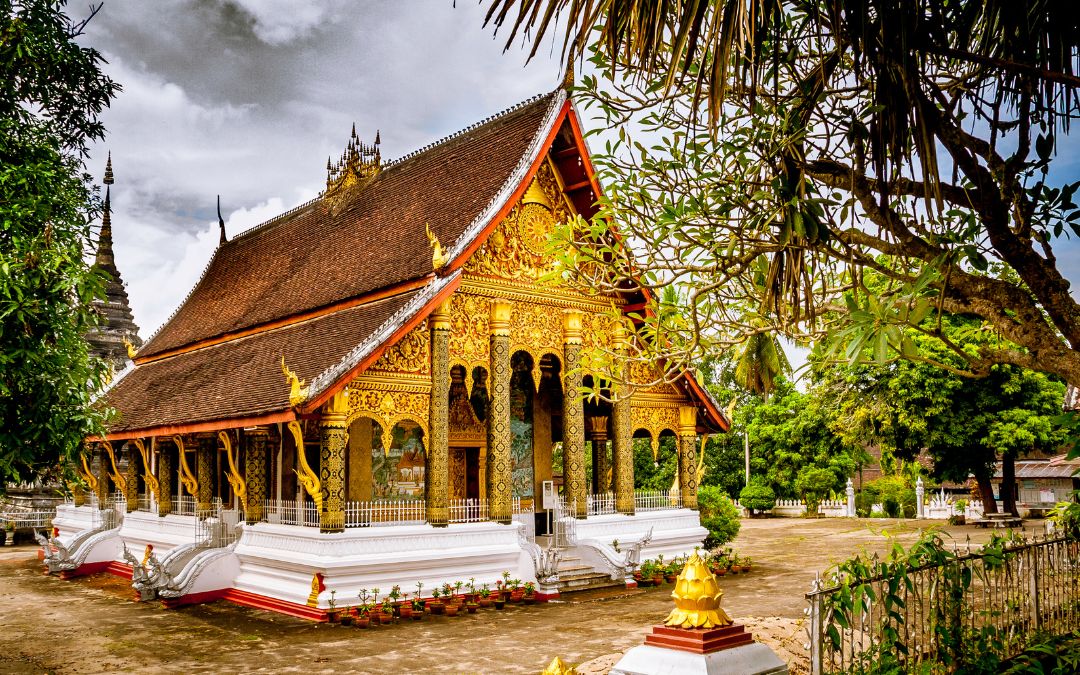
The old city of Luang Prabang, with its unique architecture
Things To Do In Luang Prabang
- Explore the Old Town
Luang Prabang’s Old Town is a treasure trove of well-preserved traditional architecture, narrow alleys, and charming colonial-era buildings. Take a leisurely stroll through the town’s UNESCO-protected streets and admire the blend of Lao, French, and Indochinese influences. Explore the vibrant local markets, visit traditional art galleries, and stop by the Royal Palace Museum to learn about the city’s royal history. The Old Town’s relaxed atmosphere and architectural beauty make it a delight to explore on foot.
- Visit the Temples
Luang Prabang is renowned for its temples, which stand as testaments to the city’s deep-rooted spiritual traditions. Wat Xieng Thong, the city’s most revered temple, is a masterpiece of Lao religious art and architecture. Admire its sweeping rooflines, intricate mosaics, and golden stupas. Wat Mai, with its stunning golden façade, and Wat Visounnarath, known for its iconic watermelon-shaped stupa, are also must-visit sites. Take part in the sacred morning alms-giving ritual, where locals offer food to Buddhist monks, for a deeply immersive cultural experience.
- Witness the Tak Bat Ceremony
One of the most sacred and revered traditions in Luang Prabang is the Tak Bat ceremony, also known as the Alms Giving Ceremony. Wake up early to witness the procession of orange-robed monks as they silently walk through the streets, collecting alms from devout locals and visitors. This serene and spiritual experience allows you to observe and participate in an ancient Buddhist tradition while showing respect for local customs. Remember to dress modestly and observe proper etiquette during the ceremony.
- Take a Boat Trip along the Mekong River
The mighty Mekong River flows along the outskirts of Luang Prabang, offering stunning vistas and opportunities for exploration. Embark on a boat trip along the river to witness the beauty of the surrounding landscapes and visit the nearby Pak Ou Caves. These caves are home to thousands of Buddha statues, creating a mystical and awe-inspiring sight. As you cruise on the river, you’ll be treated to panoramic views, lush greenery, and glimpses of local life along the riverbanks.
- Experience the Kuang Si Waterfalls
Located a short distance from Luang Prabang, the Kuang Si Waterfalls are a natural wonder that shouldn’t be missed. Marvel at the cascading turquoise waters as they flow gently over limestone terraces, creating a series of stunning pools. Take a refreshing dip in the cool waters, or simply relax amidst the serene natural surroundings. The waterfalls are also home to a rescue center for bears, providing a unique opportunity to observe these beautiful creatures up close.
>> See Tour: Laos Gastronomy & Heritage Tour
Ayutthaya, Thailand
Ayutthaya is a city in Thailand that was founded in 1350. It has a rich history as Thailand’s second capital and was once the world’s most populous city, with one million inhabitants by 1700.
Ayutthaya Historical Park is home to four temples—Wat Phra Ram, Wat Phra Si Sanphet, Wat Mahathat, and Wat Ratchaburana—as well as the Royal Palace and Wiharn Phra Mongkol Bophit. Exploring this once-thriving city will transport you back in time and give you a glimpse of its former glory.
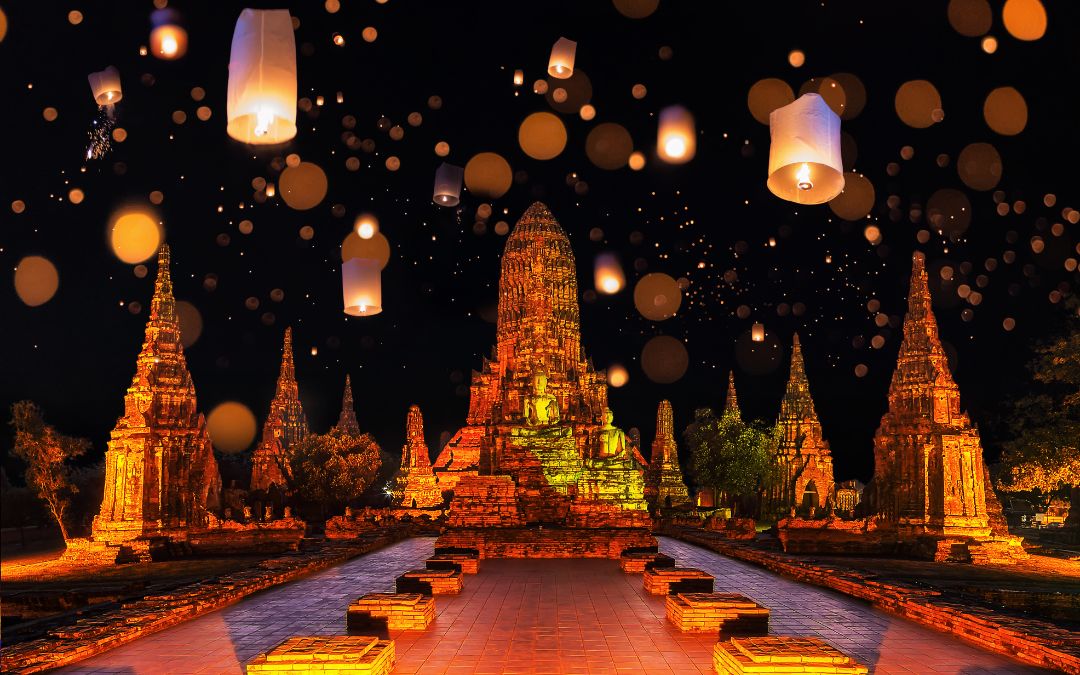
Loy Krathong festival in Ayutthaya
Things To Do In Ayutthaya
- Explore the Historical Ruins
Ayutthaya is renowned for its sprawling historical park, which is home to the impressive ruins of the once-glorious city. Wander through the ancient temples, palaces, and statues that dot the landscape, and marvel at the architectural grandeur and intricate details that have withstood the test of time. Highlights include Wat Mahathat, where the famous Buddha head entwined in tree roots can be found, and Wat Phra Si Sanphet, which was once the royal temple and houses three iconic chedis (stupas).
- Embark on a River Cruise
Discover Ayutthaya’s charm from a different perspective by embarking on a leisurely river cruise along the Chao Phraya River. Drift past the ancient ruins, lush landscapes, and traditional stilt houses, immersing yourself in the serene ambiance of the riverside. As you cruise, you’ll also have the opportunity to witness local life along the riverbanks and catch glimpses of fishermen casting their nets. A river cruise offers a tranquil escape and a unique vantage point from which to appreciate Ayutthaya’s beauty.
- Discover Ayutthaya Historical Study Center
For history enthusiasts of all ages, a visit to the Ayutthaya Historical Study Center is a must. This museum provides a comprehensive overview of Ayutthaya’s rich history through informative exhibits, artifacts, and multimedia presentations. Gain a deeper understanding of the kingdom’s rise and fall, learn about the cultural traditions and influences that shaped Ayutthaya, and appreciate the significance of this UNESCO World Heritage Site.
>> See Tour: Thailand Beach Tour and Temple Exploration
Sukhothai Historical Park, Thailand
Sukhothai Historical Park, located in Thailand, is a UNESCO World Heritage Site that was once the capital of the Kingdom of Sukhothai during the 13th century. The park is a host to the remains of temples, palaces, and statues that showcase the architectural and artistic accomplishments of the Sukhothai period. The Wat Mahathat, a magnificent temple featuring a towering Buddha statue, is situated at the center of the park.
By exploring the Sukhothai Historical Park, visitors can delve into the history and spirituality of Thailand and appreciate the intricate details of the ancient architecture.
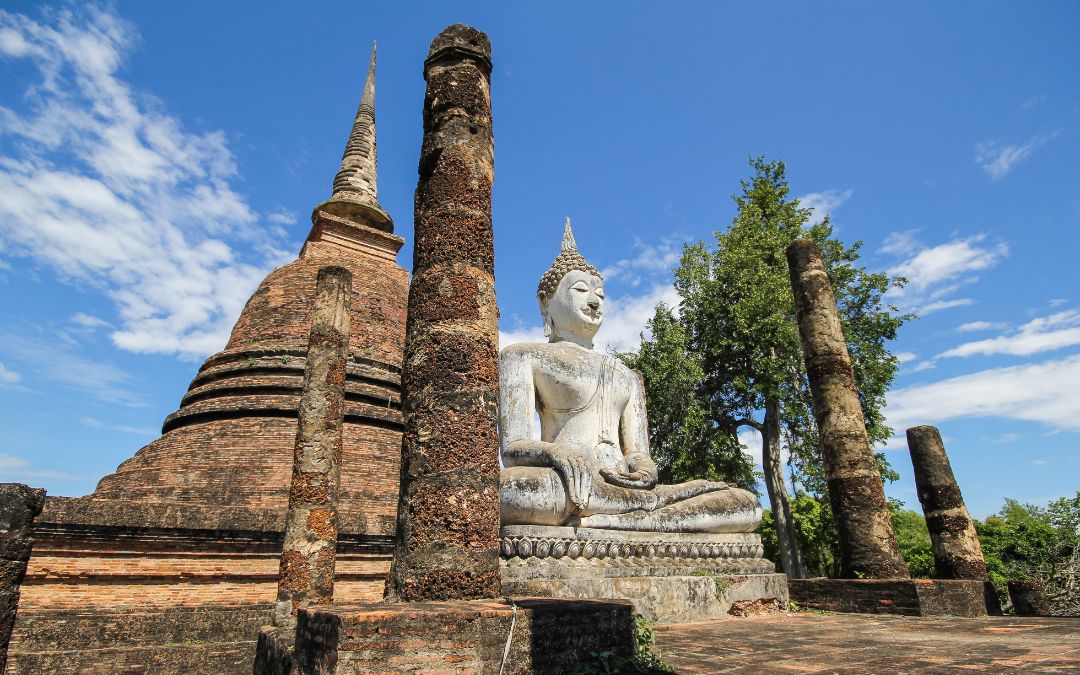
The Fine Arts Department of Thailand maintains this tourist attraction
Things To Do In Sukhothai Historical Park
- Discover the Historical Ruins
Sukhothai Historical Park features an extensive collection of ancient ruins displaying the grandeur of the once-thriving Sukhothai Kingdom. The park is divided into five zones, and you can explore these to marvel at the remnants of majestic temples, palaces, and statues. Wat Mahathat is the centerpiece, featuring a central pagoda and Buddha statues. Wat Si Chum is another must-visit site, showcasing a colossal seated Buddha image. Wander through these historical ruins and travel back in time.
- Explore On a Bicycle
One of the best ways to explore Sukhothai Historical Park is by renting a bicycle. The park’s flat terrain and well-paved paths make it ideal for leisurely rides. Pedal your way through the ancient ruins, allowing yourself to soak in the tranquil atmosphere and discover hidden corners of the park at your own pace. Cycling offers a sense of freedom and allows you to appreciate the park’s vastness while immersing yourself in nature. Don’t forget to stop and capture the breathtaking views and serene landscapes along the way.
- Witness the Ramkhamhaeng National Museum
Visiting the Ramkhamhaeng National Museum is highly recommended if you want to gain a better understanding of Sukhothai’s historical and cultural significance. The museum boasts an impressive collection of artifacts, sculptures, and exhibits that showcase the rich heritage of the Kingdom of Sukhothai. You can explore the museum’s galleries, learn about the region’s archaeological discoveries, and appreciate the intricacies of ancient Sukhothai art and craftsmanship. The Ramkhamhaeng National Museum provides an insightful glimpse into the kingdom’s past.
- Attend the Light and Sound Show
In the evenings, the Sukhothai Historical Park comes alive with a mesmerizing light and sound show that brings the ancient kingdom’s history to life. The show takes place against the backdrop of the park’s central zone, with the ruins illuminated and narrated tales of Sukhothai’s golden age. The combination of music, lights, and storytelling creates a truly immersive experience, allowing visitors to envision the grandeur and cultural significance of the Sukhothai Kingdom.
>> Read More: 13 Best Places To Visit In Thailand For First Timers
Explore The Southeast Asian Wonder With APT
Packed with wild parks, natural wonders, and ancient temples, the Southeast Asia trip is the best choice when you are searching for a bit of heritage on your well-deserved vacation with its UNESCO World Heritage Sites.
To Plan Your Perfect Trip, do not hesitate to get in touch with Asia Pioneer Travel. Our delicate travel experts will create a personalized itinerary that suits your preferences and budget. Start your journey today and discover the wonders of Southeast Asia!




